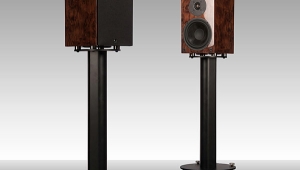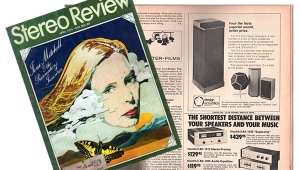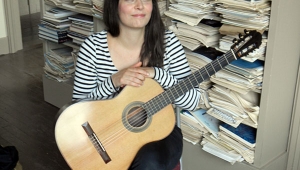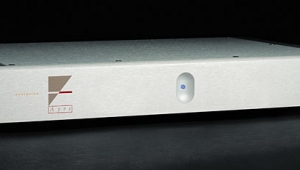| Columns Retired Columns & Blogs |
The Fifth Element #13 Page 2
The rear panel holds four pairs of RCA jacks for inputs and two for the tape-monitor loop, two pairs of substantial CE-compliant speaker-cable binding posts (single-wiring only), the power switch, power fuse, and an inlet for a detachable IEC power cord. I used Custom Power Cord Company's Top Gun HCFi AC ($1150) and Nordost's Blue Heaven interconnects and speaker cables. Replacing the stock cord with the HCFi brought about an increase in timbral palpability that surprised even me, and I'm a bit of a power-cord zealot.
Footnote: 1 "Ain't no such thing as a free lunch."—Ed.
The KT88 tubes stand about 3/8" taller than the top of the sheet-metal transformer enclosure. I infer that this is a design feature intended to discourage placing anything on top of the S2K, especially another component. The specified power consumption is 150W. There is no provision for user adjustment of tube bias voltages. The S2K ran really quite warm, but not so hot as to provoke concern, as long as ventilation was adequate. The S2K was very quiet in operation, with no transformer hum. Switch-on and switch-off were entirely drama-free.
The sound? Gloriosky, this thing just sounded right. As I said, fatigue-free tonal lusciousness. Well-recorded pop particularly benefited from the S2K's combination of smoothness and articulation in presenting inner voices and harmonies, both instrumental and vocal. Examples that come to mind included Jesse Colin Young's Light Shine (Edsel 452) and the Cowboy Junkies' The Trinity Session (Classic Compact Discs RTHCD8568). Debussy's and Ravel's string quartets by Quartetto Nuovo (Denon 33C37-7830, nla) were by turns resinous and atmospheric. Vaughan Williams' An Oxford Elegy (EMI 5 67221 2) was just sublime.
Be assured that this was not a case of first-time tube beguilement. For years, I have recommended JoLida's inexpensive all-tube amps to music-lovers on a budget. I have reviewed some tube integrated amps favorably in the past (Golden Tube, Conrad-Johnson), and heard others and been extremely impressed (Art Audio, VAC, Tenor). I also have heard a few that seemed like triumphs of ideology over common sense. I was more impressed by the Unison Research S2K's musical performance and value for money than I have been by any other amp—of any kind—in its price range.
The S2K sounded rich without being sludgy, opulent without being slow or rolled-off, relaxed without being lazy. I switched the thing on and got a whomping big dose of music. A surprisingly substantial dose, when you consider that its power output is a fraction of a typical refrigerator light bulb's.
Drawbacks? Yes, Virginia, Pliny the Elder does indeed come down the chimney once a year to write "Nunquam prandium liberum" (footnote 1) in the volcanic dust on the mantelpiece (footnote 2). So, mutatis mutandis, when I turned the S2K all the way up on the Brahms Requiem, it lost its composure and I didn't get any more bass.
For most listening through averagely efficient speakers, as long as the program material was not too bass-heavy, I never got the sense that there was any shortage of power. Does this mean that I take back all the enraptured things I've said about Halcro's amps in columns past? Not by any stretch. It doesn't even mean I take back the respectfully enthusiastic things I've said about Plinius and Jeff Rowland Design Group. Even within its limitations, the S2K might have erred (slightly) here or there on the side of euphony or soft focus. Wisely spend five or ten times as much, and you get not only more bass and dynamic range, but more musical details as well; you're that much closer to the reality.
At moderate levels, Unison's S2K was completely up to the task of critical listening to music that is not unusually demanding, if you can assimilate that distinction. If I never wanted to crank up Mahler's or Elgar's big works, I could live indefinitely with the S2K, especially for good string-quartet or vocal recordings. Bravi, bravi, bravi.
While auditioning the Unison S2K, I had two digital sources and three two-way loudspeakers to swap around, so I'll now give you capsule lowdowns on those.
Marantz SA-8260
This multichannel SACD/CD player ($1049) is elegantly designed and solidly built. By my rough measure it provided about two-thirds of the sonic refinement of Marantz' SA-14 player at about a third of that unit's $2800 price. Disc-access times were not excessive, and its tracking was quiet. Its sound quality was detailed but not edgy. Indeed, between the SA-8260's CS4397 digital chipset and its claimed attention to analog output circuitry ("HDAM modules"), its CD playback was so good that only pure-DSD SACDs could make a slam-dunk case for the new medium. Which of course they did, especially the not-for-sale Iván Fischer/Budapest Festival Orchestra demo SACD.
Default-recommending the SA-8260 at its price tier would be a no-brainer, except that Philips was kind enough to send me a review sample of their SACD1000 multichannel SACD/DVD player, which Chip Stern and Kalman Rubinson reviewed last year (footnote 3). Then, that player cost $2000. At Home Entertainment 2002 in May, Philips representatives informed me that they had lowered its list price to $1000.
Footnote: 1 "Ain't no such thing as a free lunch."—Ed.
Footnote 2: Actually, were he to write, he would probably write "NUNQUAMPRANDIUMLIBERUM." In Pliny's time, lower-case letters had not yet been invented, and, furthermore, the Romans saw no need to put spaces between words.—JM
Footnote 3: Review by Chip Stern, April 2001 (Vol.24 No.4). Follow-Up by Kalman Rubinson, June 2001 (Vol.24 No.6).
- Log in or register to post comments




































